April/2021 Latest Braindump2go AZ-400 Exam Dumps with PDF and VCE Free Updated Today! Following are some new AZ-400 Real Exam Questions!
QUESTION 265
You have an Azure DevOps organization named Contoso.
You need to recommend an authentication mechanism that meets the following requirements:
– Supports authentication from Git
– Minimizes the need to provide credentials during authentication
What should you recommend?
A. personal access tokens (PATs) in Azure DevOps
B. Alternate credentials in Azure DevOps
C. user accounts in Azure Active Directory (Azure AD)
D. managed identities in Azure Active Directory (Azure AD)
Answer: A
Explanation:
Personal access tokens (PATs) give you access to Azure DevOps and Team Foundation Server (TFS), without using your username and password directly. These tokens have an expiration date from when they’re created. You can restrict the scope of the data they can access. Use PATs to authenticate if you don’t already have SSH keys set up on your system or if you need to restrict the permissions that are granted by the credential.
Incorrect Answers:
B: Azure DevOps no longer supports Alternate Credentials authentication since the beginning of March 2, 2020. If you’re still using Alternate Credentials, we [Microsoft] strongly encourage you to switch to a more secure authentication method (for example, personal access tokens).
Reference:
https://docs.microsoft.com/en-us/azure/devops/repos/git/auth-overview
QUESTION 266
You plan to onboard 10 new developers.
You need to recommend a development environment that meets the following requirements:
– Integrates with GitHub
– Provides integrated debugging tools
– Supports remote workers and hot-desking environments
– Supports developers who use browsers, tablets, and Chromebooks
What should you recommend?
A. VS Code
B. Xamarin Studio
C. MonoDevelop
D. Visual Studio Codespaces
Answer: D
Explanation:
Visual Studio Codespaces is built to accommodate the widest variety of projects or tasks, including GitHub and integrating debugging.
Visual Studio Codespaces conceptually and technically extends the Visual Studio Code Remote Development extensions.
In addition to “backend” environments, Visual Studio Codespaces supports these “frontend” editors:
– Visual Studio Code
– Visual Studio Code-based editor in the browser
Reference:
https://docs.microsoft.com/sv-se/visualstudio/codespaces/overview/what-is-vsonline
QUESTION 267
You have an Azure subscription that contains resources in several resource groups.
You need to design a monitoring strategy that will provide a consolidated view. The solution must support the following requirements:
– Support role-based access control (RBAC) by using Azure Active Directory (Azure AD) identifies.
– Include visuals from Azure Monitor that are generated by using the Kusto query language.
– Support documentation written in markdown.
– Use the latest data available for each visual.
What should you use to create the consolidated view?
A. Azure Monitor
B. Microsoft Power BI
C. Azure Data Explorer
D. Azure dashboards
Answer: C
Explanation:
There are several tools available for running queries in Azure Data Explorer, including Kusto.
Kusto uses a role-based access control (RBAC) model, under which authenticated principals are mapped to roles, and get access according to the roles they’re assigned.
Note: Azure Data Explorer is a highly scalable and secure analytics service that enables you to do rich exploration of structured and unstructured data for instant insights. Optimized for ad-hoc queries, Azure Data Explorer enables rich data exploration over raw, structured, and semi-structured data delivering fast time to insight. Query with a modern, intuitive query language that offers fast, ad-hoc, and advanced query capabilities over high-rate data volumes and varieties
Reference:
https://docs.microsoft.com/en-us/azure/data-explorer/tools-integrations-overview
QUESTION 268
Note: This question is part of a series of questions that present the same scenario. Each question in the series contains a unique solution that might meet the stated goals. Some question sets might have more than one correct solution, while others might not have a correct solution.
After you answer a question in this section, you will NOT be able to return to it. As a result, these questions will not appear in the review screen.
The lead developer at your company reports that adding new application features takes longer than expected due to a large accumulated technical debt.
You need to recommend changes to reduce the accumulated technical debt.
Solution: You recommend reducing the code coupling and the dependency cycles?
Does this meet the goal?
A. Yes
B. No
Answer: B
Explanation:
Instead reduce the code complexity.
Note: Technical debt is the accumulation of sub-optimal technical decisions made over the lifetime of an application. Eventually, it gets harder and harder to change things: it’s the `sand in the gears’ that sees IT initiatives grind to a halt.
Reference:
https://dzone.com/articles/fight-through-the-pain-how-to-deal-with-technical
https://www.devopsgroup.com/blog/five-ways-devops-helps-with-technical-debt/
QUESTION 269
You are building an ASP.NET Core application.
You plan to create an application utilization baseline by capturing telemetry data.
You need to add code to the application to capture the telemetry data. The solution must minimize the costs of storing the telemetry data.
Which two actions should you perform? Each correct answer presents part of the solution.
NOTE: Each correct selection is worth one point
A. Add the <InitialSamplingPercentage>99</InitialSamplingPercentage> parameter to the ApplicationInsights.config file.
B. From the code of the application, enable adaptive sampling.
C. From the code of the application, add Azure Application Insights telemetry.
D. Add the <MaxTelemetryItemsPerSecond>5</MaxTelemetryItemsPerSecond> parameter to the ApplicationInsights.config file.
E. From the code of the application, disable adaptive sampling.
Answer: BD
Explanation:
Sampling is a feature in Azure Application Insights. It is the recommended way to reduce telemetry traffic, data costs, and storage costs, while preserving a statistically correct analysis of application data.
The Application Insights SDK for ASP.NET Core supports both fixed-rate and adaptive sampling. Adaptive sampling is enabled by default.
D: For adaptive sampling: The volume is adjusted automatically to keep within a specified maximum rate of traffic, and is controlled via the setting MaxTelemetryItemsPerSecond. If the application produces a low amount of telemetry, such as when debugging or due to low usage, items won’t be dropped by the sampling processor as long as volume is below MaxTelemetryItemsPerSecond.
Note: In ApplicationInsights.config, you can adjust several parameters in the AdaptiveSamplingTelemetryProcessor node. The figures shown are the default values:
< MaxTelemetryItemsPerSecond>5</MaxTelemetryItemsPerSecond>
Reference:
https://docs.microsoft.com/en-us/azure/azure-monitor/app/sampling
QUESTION 270
You have an Azure DevOps organization named Contoso and an Azure subscription. The subscription contains an Azure virtual machine scale set named VMSS1 and an Azure Standard Load Balancer named LB1. LB1 distributes incoming requests across VMSS1 instances.
You use Azure DevOps to build a web app named App1 and deploy App1 to VMSS1. App1 is accessible via HTTPS only and configured to require mutual authentication by using a client certificate.
You need to recommend a solution for implementing a health check of App1. The solution must meet the following requirements:
Identify whether individual instances of VMSS1 are eligible for an upgrade operation.
Minimize administrative effort.
What should you include in the recommendation?
A. an Azure Load Balancer health probe
B. Azure Monitor autoscale
C. the Custom Script Extension
D. the Application Health extension
Answer: D
Explanation:
Monitoring your application health is an important signal for managing and upgrading your deployment.
Azure virtual machine scale sets provide support for rolling upgrades including automatic OS-image upgrades, which rely on health monitoring of the individual instances to upgrade your deployment. You can also use health extension to monitor the application health of each instance in your scale set and perform instance repairs using automatic instance repairs.
Reference:
https://docs.microsoft.com/en-us/azure/virtual-machine-scale-sets/virtual-machine-scale-sets-health-extension
QUESTION 271
You have an existing build pipeline in Azure Pipelines.
You need to use incremental builds without purging the environment between pipeline executions.
What should you use?
A. a self-hosted agent
B. Microsoft-hosted parallel jobs
C. a File Transform task
Answer: A
Explanation:
When you run a pipeline on a self-hosted agent, by default, none of the subdirectories are cleaned in between two consecutive runs. As a result, you can do incremental builds and deployments, provided that tasks are implemented to make use of that. You can override this behavior using the workspace setting on the job.
Incorrect Answers:
B: The workspace clean options are applicable only for self-hosted agents. When using Microsoft-hosted agents, job are always run on a new agent.
Reference:
https://docs.microsoft.com/en-us/azure/devops/pipelines/process/phases
QUESTION 272
You manage an Azure web app that supports an e-commerce website.
You need to increase the logging level when the web app exceeds normal usage patterns. The solution must minimize administrative overhead.
Which two resources should you include in the solution? Each correct answer presents part of the solution.
NOTE: Each correct selection is worth one point.
A. an Azure Automation runbook
B. an Azure Monitor alert that has a dynamic threshold
C. an Azure Monitor alert that has a static threshold
D. the Azure Monitor autoscale settings
E. an Azure Monitor alert that uses an action group that has an email action
Answer: AB
Explanation:
B: Metric Alert with Dynamic Thresholds detection leverages advanced machine learning (ML) to learn metrics’ historical behavior, identify patterns and anomalies that indicate possible service issues. It provides support of both a simple UI and operations at scale by allowing users to configure alert rules through the Azure Resource Manager API, in a fully automated manner.
A: You can use Azure Monitor to monitor base-level metrics and logs for most services in Azure. You can call Azure Automation runbooks by using action groups or by using classic alerts to automate tasks based on alerts.
Reference:
https://docs.microsoft.com/en-us/azure/azure-monitor/platform/alerts-dynamic-thresholds
https://docs.microsoft.com/en-us/azure/automation/automation-create-alert-triggered-runbook
QUESTION 273
You have a build pipeline in Azure Pipelines that occasionally fails.
You discover that a test measuring the response time of an API endpoint causes the failures.
You need to prevent the build pipeline from failing due to the test.
Which two actions should you perform? Each correct answer presents part of the solution.
NOTE: Each correct selection is worth one point.
A. Set Flaky test detection to Off.
B. Clear Flaky tests included in test pass percentage.
C. Enable Test Impact Analysis (TIA).
D. Manually mark the test as flaky.
E. Enable test slicing.
Answer: BD
Explanation:
D: You can mark or unmark a test as flaky based on analysis or context, by choosing Flaky.
To configure flaky test management, choose Project settings, and select Test management in the Pipelines section.
B: Slide the On/Off button to On.

Reference:
https://docs.microsoft.com/en-us/azure/devops/pipelines/test/flaky-test-management
QUESTION 274
Note: This question is part of a series of questions that present the same scenario. Each question in the series contains a unique solution that might meet the stated goals. Some question sets might have more than one correct solution, while others might not have a correct solution.
After you answer a question in this section, you will NOT be able to return to it. As a result, these questions will not appear in the review screen.
You have an Azure DevOps project.
Your build process creates several artifacts.
You need to deploy the artifacts to on-premises servers.
Solution: You deploy an Octopus Deploy server. You deploy a polled Tentacle agent to an on-premises server. You add an Octopus task to the deployment pipeline.
Does this meet the goal?
A. Yes
B. No
Answer: B
Explanation:
Instead you should deploy an Azure self-hosted agent to an on-premises server.
Note: To build your code or deploy your software using Azure Pipelines, you need at least one agent.
If your on-premises environments do not have connectivity to a Microsoft-hosted agent pool (which is typically the case due to intermediate firewalls), you’ll need to manually configure a self-hosted agent on on-premises computer(s).
Reference:
https://docs.microsoft.com/en-us/azure/devops/pipelines/agents/agents?view=azure-devops
QUESTION 275
You have an Azure DevOps project named Project1 and an Azure subscription named Sub1.
You need to prevent releases from being deployed unless the releases comply with the Azure Policy rules assigned to Sub1.
What should you do in the release pipeline of Project1?
A. Add a deployment gate.
B. Modify the Deployment queue settings.
C. Configure a deployment trigger.
D. Create a pipeline variable.
Answer: A
Explanation:
You can check policy compliance with gates.
You can extend the approval process for the release by adding a gate. Gates allow you to configure automated calls to external services, where the results are used to approve or reject a deployment.
You can use gates to ensure that the release meets a wide range or criteria, without requiring user intervention.
Reference:
https://docs.microsoft.com/en-us/azure/devops/pipelines/release/deploy-using-approvals
QUESTION 276
You have a project in Azure DevOps named Project1. Project1 contains a build pipeline named Pipe1 that builds an application named App1.
You have an agent pool named Pool1 that contains a Windows Server 2019-based self-hosted agent.
Pipe1 uses Pool1.
You plan to implement another project named Project2. Project2 will have a build pipeline named Pipe2 that builds an application named App2.
App1 and App2 have conflicting dependencies.
You need to minimize the possibility that the two build pipelines will conflict with each ether. The solution must minimize infrastructure costs.
What should you do?
A. Add another self-hosted agent.
B. Adds Docker Compose task to the build pipelines.
C. Change the self-hosted agent to use Red Hat Enterprise Linux (RHEL) 8.
D. Create two container jobs.
Answer: D
Explanation:
To get more control over software dependencies and operating system, you can use Container jobs. Note that the decisions whether to run your pipeline inside a container and whether to use a self-hosted agent are independent. You can directly run your pipeline on a self-hosted agent, or inside a container. You can also execute your pipeline in a container on a Microsoft-hosted agent or on a self-hosted agent.
Incorrect Answers:
A: For additional control over hardware, you can use a self-hosted build agent.
Reference:
http://thewindowsupdate.com/2019/09/09/resolving-complex-software-and-hardware-dependencies-in-azure-devops-pipelines/
QUESTION 277
You have an Azure DevOps project that uses many package feeds.
You need to simplify the project by using a single feed that stores packages produced by your company and packages consumed from remote feeds. The solution must support public feeds and authenticated feeds.
What should you enable in DevOps?
A. Universal Packages
B. upstream sources
C. views in Azure Artifacts
D. a symbol server
Answer: B
Explanation:
Upstream sources enable you to use a single feed to store both the packages you produce and the packages you consume from “remote feeds”. This includes both public feeds, such as npmjs.com and nuget.org, and authenticated feeds, such as other Azure DevOps feeds in your organization. Once you’ve enabled an upstream source, any user connected to your feed can install a package from the remote feed, and your feed will save a copy.
Reference:
https://azure.microsoft.com/en-us/blog/deep-dive-into-azure-artifacts/
QUESTION 278
You are monitoring the health and performance of an Azure web app by using Azure Application Insights.
You need to ensure that an alert is sent when the web app has a sudden rise in performance issues and failures.
What should you use?
A. custom events
B. Application Insights Profiler
C. usage analysis
D. Smart Detection
E. Continuous export
Answer: D
Explanation:
Smart Detection automatically warns you of potential performance problems and failure anomalies in your web application. It performs proactive analysis of the telemetry that your app sends to Application Insights.
If there is a sudden rise in failure rates, or abnormal patterns in client or server performance, you get an alert.
Reference:
https://docs.microsoft.com/en-us/azure/azure-monitor/app/proactive-diagnostics
QUESTION 279
You have a build pipeline in Azure Pipelines.
You create a Slack App Integration.
You need to send build notifications to a Slack channel named #Development.
What should you do first?
A. Create a project-level notification.
B. Configure a service connection.
C. Create a global notification.
D. Creates a service hook subscription.
Answer: D
Explanation:
Create a service hook for Azure DevOps with Slack to post messages to Slack in response to events in your Azure DevOps organization, such as completed builds, code changes, pull requests, releases, work items changes, and more.
Note:
1. Go to your project Service Hooks page:
https://{orgName}/{project_name}/_settings/serviceHooks Select Create Subscription.
3. Choose the types of events you want to appear in your Slack channel.
4. Paste the Web Hook URL from the Slack integration that you created and select Finish.
5. Now, when the event you configured occurs in your project, a notification appears in your team’s Slack channel.
Reference:
https://docs.microsoft.com/en-us/azure/devops/service-hooks/services/slack
QUESTION 280
You have a private GitHub repository.
You need to display the commit status of the repository on Azure Boards.
What should you do first?
A. Configure multi-factor authentication (MFA) for your GitHub account.
B. Add the Azure Pipelines app to the GitHub repository.
C. Add the Azure Boards app to the repository.
D. Create a GitHub action in GitHub.
Answer: C
Explanation:
To connect Azure Boards to GitHub.com, connect and configure from Azure Boards. Or, alternatively, install and configure the Azure Boards app from GitHub. Both methods have been streamlined and support authenticating and operating via the app rather than an individual.
Note (see step 4 below):
Add a GitHub connection:
1. Sign into Azure Boards.
2. Choose (1) Project Settings, choose (2) GitHub connections and then (3) Connect your GitHub account.
3. If this is your first time connecting to GitHub from Azure Boards, you will be asked to sign in using your GitHub credentials. Choose an account for which you are an administrator for the repositories you want to connect to.
4. The Add GitHub Repositories dialog automatically displays and selects all GitHub.com repositories for which you are an administrator. Unselect any repositories that you don’t want to participate in the integration.

Reference:
https://docs.microsoft.com/en-us/azure/devops/boards/github/connect-to-github
QUESTION 281
Hotspot Question
You manage the Git repository for a large enterprise application.
You need to minimize the data size of the repository.
How should you complete the commands? To answer, select the appropriate options in the answer area.
NOTE: Each correct selection is worth one point.

Answer:

Explanation:
Box 1: –aggressive
Cleanup unnecessary files and optimize the local repository:
git gc –aggressive
Box 2: prune
Prune all unreachable objects from the object database:
git prune
Reference:
https://gist.github.com/Zoramite/2039636
QUESTION 282
Drag and Drop Question
You use GitHub Enterprise Server as a source code repository.
You create an Azure DevOps organization named Contoso.
In the Contoso organization, you create a project named Project1.
You need to link GitHub commits, pull requests, and issues to the work items of Project1. The solution must use OAuth-based authentication.
Which three actions should you perform in sequence? To answer, move the appropriate actions from the list of actions to the answer area and arrange them in the correct order.

Answer:

Explanation:
Step 1: From Developer settings in GitHub Enterprise Server, register a new OAuth app. If you plan to use OAuth to connect Azure DevOps Services or Azure DevOps Server with your GitHub Enterprise Server, you first need to register the application as an OAuth App
Step 2: Organization settings in Azure DevOps, add an OAuth configuration Register your OAuth configuration in Azure DevOps Services.
Note:
1. Sign into the web portal for Azure DevOps Services.
2. Add the GitHub Enterprise Oauth configuration to your organization.
3. Open Organization settings>Oauth configurations, and choose Add Oauth configuration.
4. Fill in the form that appears, and then choose Create.
Step 3: From Project Settings in Azure DevOps, add a GitHub connection. Connect Azure DevOps Services to GitHub Enterprise Server
Choose the Azure DevOps logo to open Projects, and then choose the Azure Boards project you want to configure to connect to your GitHub Enterprise repositories.
Choose (1) Project Settings, choose (2) GitHub connections and then (3) Click here to connect to your GitHub Enterprise organization.
Reference:
https://docs.microsoft.com/en-us/azure/devops/boards/github/connect-to-github
QUESTION 283
Drag and Drop Question
You are configuring an Azure DevOps deployment pipeline. The deployed application will authenticate to a web service by using a secret stored in an Azure key vault.
You need to use the secret in the deployment pipeline.
Which three actions should you perform in sequence? To answer, move the appropriate actions from the list of actions to the answer area and arrange them in the correct order.

Answer:
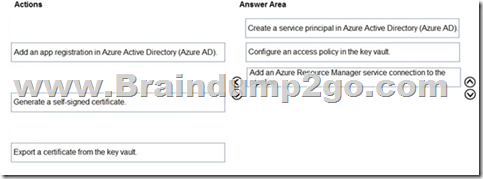
Explanation:
Step 1: Create a service principal in Azure Active Directory (Azure AD). You will need a service principal to deploy an app to an Azure resource from Azure Pipelines.
Step 2: Configure an access policy in the key vault.
You need to secure access to your key vaults by allowing only authorized applications and users. To access the data from the vault, you will need to provide read (Get) permissions to the service principal that you will be using for authentication in the pipeline.
Select Access policy and then select + Add Access Policy to setup a new policy.

Step 3: Add an Azure Resource Manager service connection to the pipeline You need to authorize the pipeline to deploy to Azure:
1. Select Pipelines | Pipelines,
2. Go to Releases under Pipelines and then select and Edit your pipeline.
3. Under Tasks, notice the release definition for Dev stage has a Azure Key Vault task. This task downloads Secrets from an Azure Key Vault. You will need to point to the subscription and the Azure Key Vault resource.
4. Click Manage, this will redirect to the Service connections page.

5. Click on New Service connection -> Azure Resource Manager -> Service Principal (manual). Fill the information from previously created service principal.
Reference:
https://azuredevopslabs.com/labs/vstsextend/azurekeyvault/
QUESTION 284
Drag and Drop Question
As part of your application build process, you need to deploy a group of resources to Azure by using an Azure Resource Manager template located on GitHub.
Which three action should you perform in sequence? To answer, move the appropriate actions from the list of actions to the answer area and arrange them in the correct order.
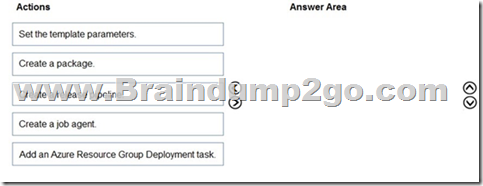
Answer:
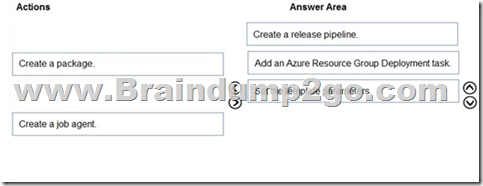
Explanation:
Step 1: Create a release pipeline
You need to create a new pipeline.
You can integrate Azure Resource Manager templates (ARM templates) with Azure Pipelines for continuous integration and continuous deployment (CI/CD).
Step 2: Add an Azure Resource Group Deployment task
Step 3: Set the template parameters
Reference:
https://docs.microsoft.com/en-us/azure/azure-resource-manager/templates/add-template-to-azure-pipelines
QUESTION 285
Drag and Drop Question
You have a project in Azure DevOps that uses packages from multiple public feeds. Some of the feeds are unreliable.
You need to consolidate the packages into a single feed.
Which three actions should you perform in sequence? To answer, move the appropriate actions from the list of actions to the answer area and arrange them in the correct order.
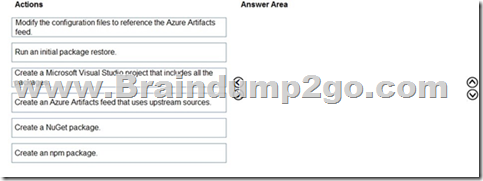
Answer:
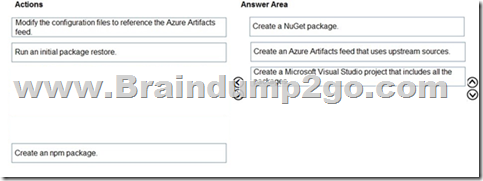
Explanation:
Step 1: Create a NuGet package.
NuGet and Maven are public package managers that support multiple feeds.
Step 2: Create an Azure Artifacts feed that uses upstream sources If you want to use packages from multiple feeds, use upstream sources to bring packages from multiple feeds together into a single feed.
Step 3: Create a Micrtosoft Visual Studio project that includes all the packages Consume NuGet packages from upstream sources: Now you can open Visual Studio and install packages from the upstream sources you just configured.
Reference:
https://docs.microsoft.com/en-us/azure/devops/artifacts/how-to/set-up-upstream-sources
Resources From:
1.2021 Latest Braindump2go AZ-400 Exam Dumps (PDF & VCE) Free Share:
https://www.braindump2go.com/az-400.html
2.2021 Latest Braindump2go AZ-400 PDF and AZ-400 VCE Dumps Free Share:
https://drive.google.com/drive/folders/1kLhX5N_Pt_noAKZD50xUpnSEA5Tt62TZ?usp=sharing
3.2021 Free Braindump2go AZ-400 Exam Questions Download:
https://www.braindump2go.com/free-online-pdf/AZ-400-VCE-Dumps(276-289).pdf
https://www.braindump2go.com/free-online-pdf/AZ-400-PDF-Dumps(265-275).pdf
Free Resources from Braindump2go,We Devoted to Helping You 100% Pass All Exams!